Ditapis dengan

INDONESIA ECONOMIC QUARTERLY Desember 2013 ; Pertumbuhan melambat; resiko tinggi
Kuartal akhir tahun 2013 telah mencatat penyesuaian ekonomi Indonesia yang masih berlangsung terhadap terus melemahnya harga-harga komoditas dan kondisi pembiayaan eksternal yang lebih ketat, dan tekanan neraca pembayaran. Sejumlah kebijakan telah menanggapinya, terutama melalui kebijakan moneter yang lebih ketat, depresiasi riil Rupiah yang cukup besar dan belanja investasi dan pertumbuhan…
- Edisi
- Desember 2013
- ISBN/ISSN
- -
- Deskripsi Fisik
- vi, 54 halaman ; 28 cm
- Judul Seri
- Textbook
- No. Panggil
- 330.05 THE i
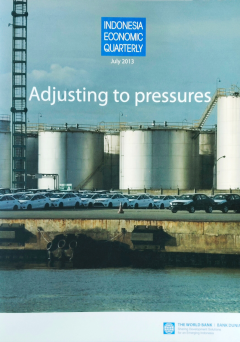
INDONESIA ECONOMIC QUARTERLY July 2013 ; Adjusting to pressures
The second quarter of 2013 was an eventful one as Indonesia's economy, policy settings and financial markets adjusted to pressures which have been mounting over recent quarters and to shifts in the global environment. Following slightly weaker-than-expected growth in the first quarter, there are signs that domestic demand, particularly investment, has continued to moderate. On the fiscal front,…
- Edisi
- Juli 2013
- ISBN/ISSN
- -
- Deskripsi Fisik
- x, 46 halaman ; 28 cm
- Judul Seri
- Textbook
- No. Panggil
- 330.05 THE i

INDONESIA ECONOMIC QUARTERLY July 2014 ; Hard choices
GDP growth in the first quarter of 2014 moderated further to 5.2 percent year-on-year, from 5.7 percent year-on-year in the prior quarter. The slower growth rate is due partly to the macro stabilizing monetary and exchange rate policy measures that have been taken to move to a more sustainable current account footing and enhance investor confidence. However, exports have remained sluggish, in p…
- Edisi
- Juli 2014
- ISBN/ISSN
- -
- Deskripsi Fisik
- iv, 52 halaman ; 28 cm
- Judul Seri
- Textbook
- No. Panggil
- 330.05 THE i

INDONESIA ECONOMIC QUARTERLY June 2010 ; Continuity amidst volatility
The Indonesian economic quarterly reports on and synthesizes the past three months' key developments in Indonesia's economy. It places them in a longer-term and global context, and assesses the implications of these developments and other changes in policy for the outlook for Indonesia's economic and social welfare. Its coverage ranges from the macro economy to financial markets to indicators o…
- Edisi
- Juni 2010
- ISBN/ISSN
- -
- Deskripsi Fisik
- iii, 55 halaman ; 28 cm
- Judul Seri
- Textbook
- No. Panggil
- 330.05 THE i

INDONESIA ECONOMIC QUARTERLY June 2011 ; Current challenges, future potential
Indonesia's economic performance through mid-2011 has been positive. Solid growth has been accompanied by further portfolio capital and foreign direct investment inflows. Public and financial sector balance sheets remain strong. However, events over the past quarter serve as a reminder of a number of Indonesia's ongoing policy challenges. At the same time, the launch of the government's master …
- Edisi
- Juni 2011
- ISBN/ISSN
- -
- Deskripsi Fisik
- ix, 44 halaman ; 28 cm
- Judul Seri
- Textbook
- No. Panggil
- 330.05 THE i
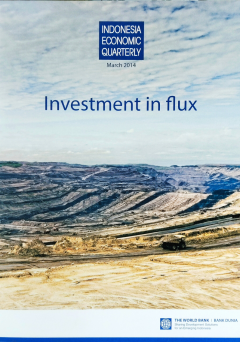
INDONESIA ECONOMIC QUARTERLY March 2014 ; Investment in flux
The fourth quarter of 2013 brought welcome signs that Indonesia’s economy is rebalancing in response to previous monetary policy and exchange rate adjustments, which is positive for macroeconomic stability. The overall economic growth rate was broadly unchanged, at 5.7 percent year-on-year, but the composition of growth tilted more towards net exports while fixed investment remained subdued.
- Edisi
- Maret 2014
- ISBN/ISSN
- -
- Deskripsi Fisik
- iv, 53 halaman ; 28 cm
- Judul Seri
- Textbook
- No. Panggil
- 330.05 THE i

INDONESIA ECONOMIC QUARTERLY Maret 2014 ; Investasi yang tak menentu
Ekonomi Indonesia terus menyesuaiakan diri ditandai dengan pelemahan nilai tukar perdagangan (terms of trade) dan pengetatan kondisi pendanaan luar negeri, dengan komposisi pertumbuhan yang lebih di dominasi oleh ekspor bersih diserta dengan pertumbuhan ekonomi yang sedikit melambat. Sementara penyesuaian yang dilakukan bersifat positif bagi stabilitas ekonomi makro, apa yang terus – mene…
- Edisi
- Maret 2014
- ISBN/ISSN
- -
- Deskripsi Fisik
- v, 58 halaman ; 28 cm
- Judul Seri
- Textbook
- No. Panggil
- 330.05 THE i
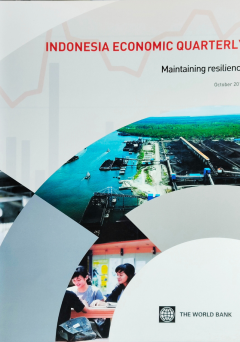
INDONESIA ECONOMIC QUARTERLY October 2012 ; Maintaining resilience
Indonesia’s growth performance has remained robust in the face of global economic weakness but, with risks remaining high, the economy’s resilience to future shocks can be further strengthened through a continued focus on crisis preparedness, on facilitating investment and on improving the quality of public spending.
- Edisi
- Oktober 2012
- ISBN/ISSN
- -
- Deskripsi Fisik
- ix, 44 halaman ; 28 cm
- Judul Seri
- Textbook
- No. Panggil
- 330.05 THE i
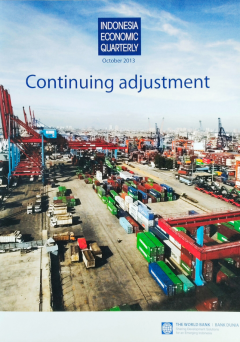
INDONESIA ECONOMIC QUARTERLY October 2013 ; Continuing adjustment
This outlook of a moderate slowdown in growth to just above 5 percent depends on Indonesia avoiding more binding external financing pressures. This depends on global funding conditions remaining sufficiently supportive, and on how well Indonesia’s policies facilitate continued near-term adjustment, and support competitiveness and investment.
- Edisi
- Oktober 2013
- ISBN/ISSN
- -
- Deskripsi Fisik
- iv, 55 halaman ; 28 cm
- Judul Seri
- Textbook
- No. Panggil
- 330.05 THE i
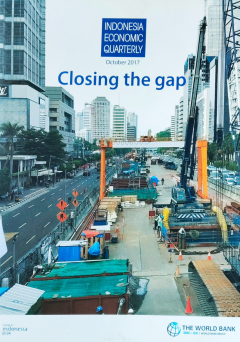
INDONESIA ECONOMIC QUARTERLY October 2017 ; Closing the gap
Private consumption growth unexpectedly remained unchanged in Q2. The steady momentum in private consumption, which accounts for over half of Indonesia’s GDP, stands in contrast to several favorable drivers, such as strong job growth, double-digit wage increases and the shifting of the Idul Fitri festive season to Q2 this year
- Edisi
- Oktober 2017
- ISBN/ISSN
- -
- Deskripsi Fisik
- iv, 63 halaman ; 28 cm
- Judul Seri
- Textbook
- No. Panggil
- 330.05 THE i
 Karya Umum
Karya Umum  Filsafat
Filsafat  Agama
Agama  Ilmu-ilmu Sosial
Ilmu-ilmu Sosial  Bahasa
Bahasa  Ilmu-ilmu Murni
Ilmu-ilmu Murni  Ilmu-ilmu Terapan
Ilmu-ilmu Terapan  Kesenian, Hiburan, dan Olahraga
Kesenian, Hiburan, dan Olahraga  Kesusastraan
Kesusastraan  Geografi dan Sejarah
Geografi dan Sejarah